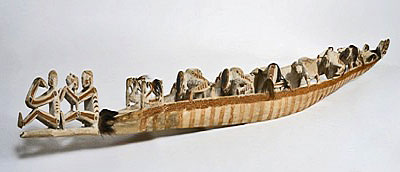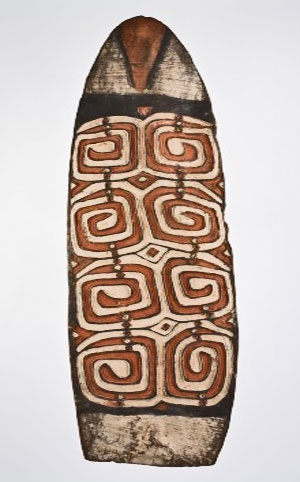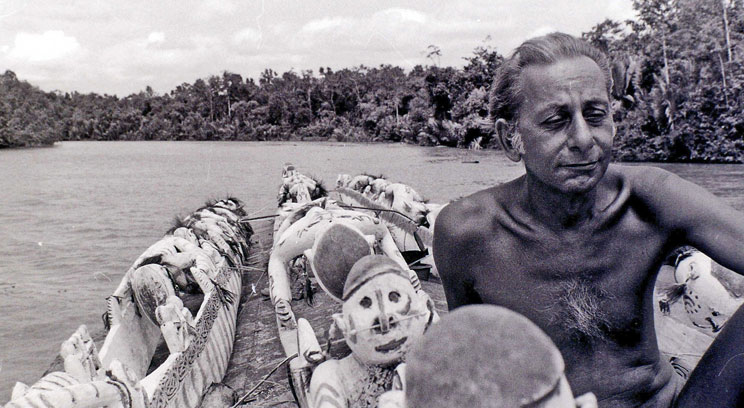“Among the Asmat: The Schneebaum Perspective"
One of the more unusual individuals to emerge from the worlds of 20th century art and anthropology figures prominently in the American Museum of Asmat Art’s latest exhibition at the University of St. Thomas.
The exhibit, “Among the Asmat: The Schneebaum Perspective,” is free and open to the public and can be seen through March 7, 2014, in The Gallery, located on the second floor of the Anderson Student Center on the university’s St. Paul campus.
The Asmat people – who inhabit a remote region of Papua, Indonesia – are known for their traditional and contemporary carvings. They live in several hundred villages that are located in tidal and freshwater swamps and lowland rainforests. The challenges of reaching this part of southwestern Papua meant the Asmat had little contact with the outside world until the 1950s.
All told, Schneebaum spent more than a decade living among the Asmat and traveling between Papua and the United States. His first visit was in 1973 and his last was in 1998 when he traveled there for a documentary filmed about his life, “Keep the River on Your Right: A Modern Cannibal Tale,” which won a 2001 Independent Spirit Award.

Tobias Schneebaum drew this picture of Amandos Amonos, the lead carver of the 20-foot spirit canoe owned by the American Museum of Asmat Art at St. Thomas.
Schneebaum was born on Manhattan’s Lower East Side in 1922; he grew up in Brooklyn and graduated from City College of New York, where he studied mathematics and art. After serving as an Army radar repairman during World War II, he studied art at the Brooklyn Museum of Art and later received master’s degrees in anthropology from The New School in New York and Goddard College in Vermont.
Prior to his extended visits to Indonesia, Schneebaum lived and painted in remote areas of Mexico and Peru. In addition to half a dozen solo art exhibitions in New York between 1953 and 1970, he wrote seven books, mostly about his experiences with the Asmat: Keep the River on Your Right (1969), Wild Man (1979), Asmat: Life With the Ancestors (1981), Asmat Images: The Asmat Museum of Culture and Progress (1989), Embodied Spirits: Ritual Carvings of the Asmat (1990), and Secret Places: My Life in New York and New Guinea (2000).
The American Crosier Fathers and brothers began collecting Asmart art when they first arrived in Papua 60 years ago. Schneebaum, who served from 1973 to 1983 as assistant curator of the Asmat Museum of Culture and Progress in the Papua city of Agats, joined the missionaries on collecting trips to Asmat communities; they would trade axes, machetes, fish hooks and tobacco for drums, shields, nosepieces and figurative carvings.
Schneebaum later catalogued the collection of Asmat carvings that were moved to the Crosier Art Museum in Hastings, Neb. In 1997 the collection was moved to Shoreview, Minn., and in 2007 more than 1,400 pieces came to St. Thomas, a gift of the American Crosier Fathers and Brothers and the Diocese of Agats.
The collection, one of the most comprehensive of its kind in the United States, has since grown to more than 2,000 pieces and includes finely crocheted masks, intricately carved shields, long “spirit canoes” and tall ancestor or bisj poles. The St. Thomas-based American Museum of Asmat Art is the only one that has continued to purchase art directly from Asmat artists in recent years.

A spirit canoe, or wuramon, is among the largest carvings the collection of the American Museum of Asmat Art.
It was during his years as a curator at the museum in Agats that Schneebaum encouraged Asmat carvers to create a full-size spirit canoe, or wuramon, because the museum did not yet have a full-size example of one. That work, at 20-feet long, is the largest item in the exhibition.
In addition to the canoe, the exhibition features a paddle, spear, bowl, turtle-shaped headrest and a necklace made of 114 dog teeth. There are multiple examples of drums, tobacco pipes and two large, carved crocodiles. The spear and intricate bowl included in the exhibition were carved by Sai, an Asmat who was Schneebaum's adoptive father.
One of the few items that was not carved is an intricate spirit mask made of palm leaves, ratton, string, and cassowary and cockatoo feathers. Another is a drawing in soot of a cassowary, a large bird, on a section of tree trunk. The rare work was found by Schneebaum, Father Edward Greiwe and Bishop Alphonse Sowada during a visit to the Wagobis area.
One of the exhibition’s largest displays – 12 tall, wooden shields – illustrates Schneebaum’s twin backgrounds as anthropologist and artist. In addition to taking extensive notes during his travels to Asmat villages, he created 300 drawings of the collected artifacts and, in some cases, their artists. Several of his drawings are part of the exhibition.

The American Museum of Asmat Art has 65 carved shields in its collection. Twelve of them were selected for the current exhibition on Tobias Schneebaum.
It was in the process of creating his intricate shield sketches that Schneebaum began to recognize specific patterns based on geographic regions.
“I started by lining up the 167 shields in the storage and education rooms,” he wrote. “It took several weeks to give tentative places of origin. When I began drawing the shields, I was able to see similarities and differences that I had not noticed before.”
“He contributed significantly to the field of Asmat cultural studies,” explained Gretchen Burau, the St. Thomas art history graduate student who curated the exhibition. “He defined four specific regions for shields that were based on overall shape and the patterns sculpted and painted on them.”
Burau, who worked months to assemble the exhibition, studied the 65 shields in St. Thomas’ collection and selected 12 that provide three examples from each of the four Asmat regions.
His illustrations, Burau said, are among the first published documentations of Asmat art. Many are found his 1989 Asmat Images. “Through these drawings, Schneebaum would gain a detailed understanding of repeated imagery and was eventually able to decipher specific symbols and their meanings. He formed connections that helped tie certain villages and specific artists to their art, which was carefully recorded for the museum.”
Burau is an artist who has a bachelor’s in art from Bradley University and a master’s in painting from the Minneapolis College of Art and Design. “It is disappointing to know that I’ll never have the opportunity to meet Tobias Schneebaum,” she said. “I would especially like to talk to him about his drawings of people. There is a real sensitivity to his work.”
The exhibition also features video segments from the documentary of his life that was produced by its directors and producers, David and Laurie Gwen Shapiro.
With permission from the directors, art history graduate assistants Sara Church and Abby Gilmore, along with museum director Dr. Julie Risser, chose segments that include early, black-and-white footage of Schneebaum visiting with Asmat artists and a short interview with carver Petrus from the village of Biwar-Laut.
At one point in the documentary, Schneebaum comments as he sits in a canoe, “I only know that I like to put myself into positions whereby I become part of the landscape; I become part of the world.”
“Wherever I went, I drew,” he says in a recorded interview. “And I made drawings over many parts of the world, and indeed made paintings out of those drawings. And therefore it allowed me to do almost anything, and to see almost anything.”
As he wrote in his Secret Places, “Throughout my life, I have been searching for a way to connect with other human beings. Suddenly, I find myself in a forest among the Asmat, living in their world of spirits, where I lose my insecurities and am content.”
After returning to the United States, Schneebaum organized exhibitions of Asmat art in this country and Germany. In 1990 he organized a trip that brought a group of Asmats to the United States to demonstrate carving and dancing.
He spent his final years living with a community of artists in Greenwich Village, New York City, and was 83 when he died in 2005 in Great Neck, N.Y.
Schneebaum donated his personal Asmat shield collection to the Metropolitan Museum of Art. A large collection of his correspondence and illustrations are housed at the University of Minnesota’s Jean-Nickolaus Tretter Collection in Gay, Lesbian, Bisexual and Transgender Studies.
In addition to the museum at St. Thomas, large collections of Asmat art and artifacts can be found at the Metropolitan Museum of Art in New York City and the Tropenmuseum in Amsterdam. In 2009, the Minneapolis Institute of Arts displayed 72 pieces from the St. Thomas collection during a four-month exhibition. Some art historians believe that Asmat art influenced modernist and surrealist Western artists such as Henri Matisse, Marc Chagall and Pablo Picasso.
Exhibition hours are from 10 a.m. to 4 p.m. Mondays through Wednesdays; from 10 a.m. to 8 p.m. Thursdays; from 10 a.m. to 2 p.m. Fridays; and from noon to 4 p.m. on weekends. More information is available at (651) 962-5512 and the museum’s website.
The American Museum of Asmat Art will host an exhibition reception at 6 p.m. Saturday, Nov. 9, in The Gallery.









